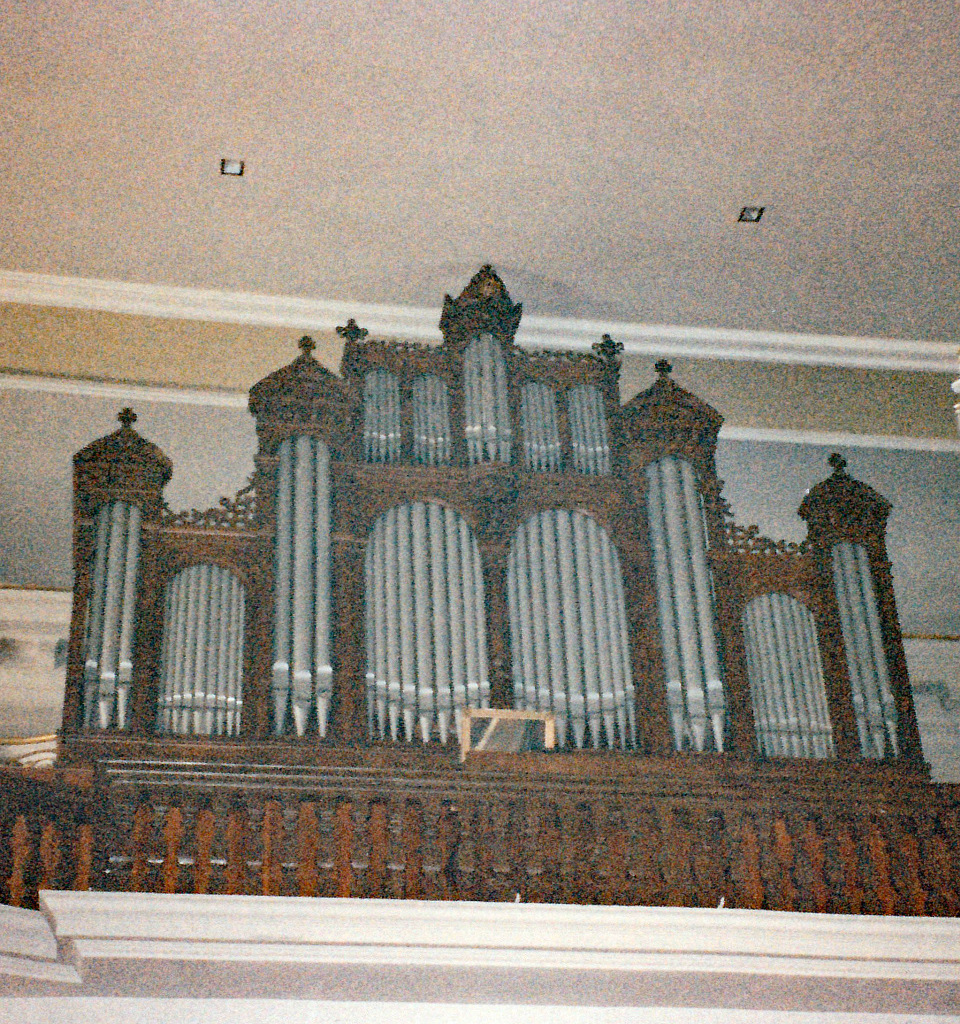Complete description of the selected organ

Photo: Bram Luteyn
Rosheim, France (Bas-Rhin (67)) - Église Saint-Etienne
Municipal: Rosheim
Region:Alsace
Address: Place Saint-Etienne, 67560, Rosheim
Description nr.: 2021309.
Built by: Stiehr-Mockers (1860)
Technical data
Specification
Grand Orgue (C-g'''): Montre 16', Bourdon 16', Montre 8', Bourdon 8', Flûte Majeure 8', Cor des Alpes 8', Violoncelle 8', Prestant 4', Flûte à Cheminée 4', Nasard 2 2/3', Doublette 2', Cornet 5 rangs (discant), Fourniture 4 rangs, Trompette 8'.
Positif (C-g'''): Flûte à cheminée 16', Diapason 8', Quintaton 8', Flûte traversière 8', Salicional 8', Unda Maris 8', Flûte Douce 4', Quinte 2 2/3', Flageolet 2', Tierce 1 3/5', Piccolo 1', Cromorne 8', Voix Humaine 8', Trémolo.
Récit (C-g'''): Quintaton 16', Principal 8', Cor de Nuit 8', Flûte Harmonique 8', Viole de Gambe 8', Voix Céleste 8', Flûte Octaviante 4', Fugara 4', Octavin 2', Plein-Jeu 5 rangs, Basson 16', Trompette Harmonique 8', Basson/Hautbois 8', Clairon 4', Trémolo.
Pédale (C-g'): Contrebasse 16', Flûte 16', Soubasse 16', Flûte 8', Bourdon 8', Violoncelle 8', Flûte 4', Bombarde 16'.
Couplers: Accouplement du Positif au Grand Orgue, Accouplement du Récit au Grand Orgue, Accouplement du Récit au Grand Orgue en 16', Accouplement du Récit au Grand Orgue en 4', Accouplement du Récit au Positif, Tirasse Grand Orgue, Tirasse Positif, Tirasse Récit, Octaves Graves Grand Orgue.

Photo: Bram Luteyn
Rosheim, France (Bas-Rhin (67)) - Église Saint-Etienne
Municipal: Rosheim
Region:Alsace
Address: Place Saint-Etienne, 67560, Rosheim
Description nr.: 2021309.
Built by: Stiehr-Mockers (1860)
| Year | Builder | Opus | Activity | 1860 | Stiehr-Mockers | new organ | 1926 | Joseph Rinckenbach | rebuild | 1953 | Pierre Lehn | rebuild | 1965 | Builder unknown | restoration |
- In the years 1857-1860 the company Stiehr-Mockers built a large three manual organ with 42 stops for the parish church of Saint-Etienne in Rosheim. In 1926 Joseph Rinckenbach converted the organ. The action was made electro-pneumatic with a free-standing console, the Echo was removed and replaced by a Récit Expressif, and the Positif that had originally been placed high in the organ was placed at the bottom.
- In 1953 the Positif was placed as a Positif de Dos (Rückpositiv) by Pierre Lehn, and in 1965 it was returned to its original position above the Grand Orgue.
Technical data
| Number of stops per division | |
| - Grand Orgue | 14 |
| - Positif | 13 |
| - Récit | 14 |
| - Pédale | 8 |
| Total number of stops | 49 |
| Key action | Electropneumatic |
| Stop action | Electropneumatic |
| Windchest(s) | Cone chests |
Specification
Grand Orgue (C-g'''): Montre 16', Bourdon 16', Montre 8', Bourdon 8', Flûte Majeure 8', Cor des Alpes 8', Violoncelle 8', Prestant 4', Flûte à Cheminée 4', Nasard 2 2/3', Doublette 2', Cornet 5 rangs (discant), Fourniture 4 rangs, Trompette 8'.
Positif (C-g'''): Flûte à cheminée 16', Diapason 8', Quintaton 8', Flûte traversière 8', Salicional 8', Unda Maris 8', Flûte Douce 4', Quinte 2 2/3', Flageolet 2', Tierce 1 3/5', Piccolo 1', Cromorne 8', Voix Humaine 8', Trémolo.
Récit (C-g'''): Quintaton 16', Principal 8', Cor de Nuit 8', Flûte Harmonique 8', Viole de Gambe 8', Voix Céleste 8', Flûte Octaviante 4', Fugara 4', Octavin 2', Plein-Jeu 5 rangs, Basson 16', Trompette Harmonique 8', Basson/Hautbois 8', Clairon 4', Trémolo.
Pédale (C-g'): Contrebasse 16', Flûte 16', Soubasse 16', Flûte 8', Bourdon 8', Violoncelle 8', Flûte 4', Bombarde 16'.
Couplers: Accouplement du Positif au Grand Orgue, Accouplement du Récit au Grand Orgue, Accouplement du Récit au Grand Orgue en 16', Accouplement du Récit au Grand Orgue en 4', Accouplement du Récit au Positif, Tirasse Grand Orgue, Tirasse Positif, Tirasse Récit, Octaves Graves Grand Orgue.
| Other specifications | |
|---|---|
| Different specifications |
De oorspronkelijke dispositie luidde: Grand Orgue (C-f'''): Montre 16', Bourdon 16', Montre 8', Flûte Majeure 8', Bourdon 8', Gemshorn 8', Gambe 8', Prestant 4', Flûte à Cheminée 4', Fugara 4', Quinte 3', Doublette 2', Cornet 5 rangs, Fourniture 5 rangs, Trompette 16', Trompette 8', Clairon 4'. Positif (C-f'''): Montre 8', Salicional 8', Bourdon 8', Flûte Douce 8', Viole d'Amour 8', Prestant 4', Flûte Ouverte 4', Salicet 4', Basson-Hautbois 8', Clarinette ou Cromorne 8'. Echo (expressif) (C-f'''): Flûte Traversière 8', Bourdon 8', Jeu Céleste 8', Montre 4', Flageolet 2', Cor Anglais 8', Voix Humaine 8'. Pédale (C-c'): Principal 16', Bourdon 16', Flûte Basse 8', Violoncelle 8', Prestant 4', Bombarde 16', Trompette 8', Clairon 4'. |
| Literature |
Historische Orgeln im Elsaß : 1489 - 1869 / P. Meyer-Siat. - München ; Zürich : Verlag Schnell & Steiner, 1983. - (98. Veröffentlichung der Gesellschaft der Orgelfreunde). |
 |
